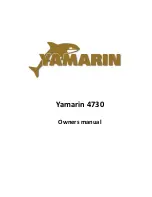
3/21/2017
Sabre 30 Owners Manual
43/81
NOTE: Any damaged or frayed wire must be repaired or replaced.
Wiring at 12 volt DC switch panel at the companionway.
Terminal strip in starboard electrical access panel.
All ground wires in starboard electrical access panel.
Wiring at engine gauges.
Engine wiring connections.
Battery cable connections at batteries and main disconnect switch.
Wiring at engine ignition panel in the cockpit.
Mast wiring plug(s) at mast step and base of mast. Both plugs should be
disassembled and cleaned. Salt deposits which can cause shorting are very common in this
area.
Wiring for all optional equipment, such as VHF radios, stereos, bilge pumps, etc.
23:00 UNDERWATER CORROSION (Cont'd)
NOTE: Optional equipment that was not factory installed must be wired with proper
switches, overcurrent protection and grounding. All switches must be installed on the
positive (+) side of the circuit with grounding being accomplished through the 12 volt DC
system to the batteries.
Unusual corrosion or deposits found at a wire connection or piece of equipment must be
thoroughly cleaned and the equipment checked for proper operation and possible electrical
leaks.
Equipment showing signs of malfunctioning or intermittent operation must also be checked.
This would include something as seemingly minor as an anchor light flickering on and off
at the top of the mast, indicating a loose connection or short circuit.
23:03 BONDING AND LIGHTENING GROUND SYSTEM: Check the entire bonding and lightening
ground systems to assure that they are intact and functioning properly. The purpose of
the bonding systems is to protect the underwater hardware from corrosion by providing a
low resistance path to ground for any stray electrical currents which may develop on the
boat. All underwater hardware is tied together with a wiring system which terminates at
one or two common ground terminals on a keel bolt in the bilge. The integrity and
operation of the bonding system can be checked by using an ohmmeter to assure that each
underwater fitting is bonded to the keel. The ohmmeter must register "0" resistance for
each fitting. The "Lightening Protection and Bonding System" diagram will help in
locating all fittings and hardware connected to the bonding system. If little or no
contact is found between a fitting and the keel, connections at each end of the wire must
be checked and the wire replaced if necessary. Particular attention should be paid to the
engine to keel bonding conductor. Our experience indicates that a poor ground connection
here can often allow a stray current to leave the boat by way of the propeller shaft.
PROPELLER AND SHAFT CORROSION: Propeller and shaft corrosion are one of the most common
results of of a stray current situation. Since the propeller and shaft are such large
pieces of hardware, with excellent electrical conductivity, they provide an ideal path for
a stray current to leave the boat.
In most cases, the propeller and shaft are adequately bonded to the keel by way of their
connection to the engine. However, if the engine to keel ground is not intact, or if a
good ground is not achieved through the shaft coupling connection to the engine, corrosion
can occur.
Even with all possible sources of stray current being minimized, if may be necessary to
install a separate ground from the propeller shaft to the keel. This is accomplished by
installation of a "shaft grounding brush" on the shaft between the stuffing box and the
Summary of Contents for Sabre 30
Page 53: ...3 21 2017 Sabre 30 Owners Manual 53 81 STEERING WHEEL RUDDER AND WHEEL ASSEMBLY...
Page 55: ...3 21 2017 Sabre 30 Owners Manual 55 81 DECK HARDWARE RIGGING GENOA TRACK INSTALLATION...
Page 57: ...3 21 2017 Sabre 30 Owners Manual 57 81 DECK HARDWARE RIGGING CHAINPLATE ASSEMBLY...
Page 70: ...3 21 2017 Sabre 30 Owners Manual 70 81 WIRING DIAGRAMS LEGEND...















































